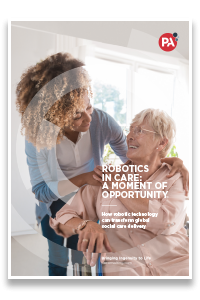The report has been developed by PA’s Robotics in Care Community of Interest (RICCOI), a forum for adult social care leaders to share their experiences of using robotic technology in social care delivery and explore further opportunities. Their insights are grounded in first-hand experience of the challenges of delivering sustainable, high-quality social care.
According to the report, Robotics in Care: A Moment of Opportunity, the coronavirus pandemic raised the prominence of technology in care, meaning many workers now have direct experience of how it can help them do their jobs better, faster and with reduced risk. The pandemic has, for example, led social care workers to facilitate virtual engagement between family and care home residents and capitalise on technology to protect those shielding by reducing the need for physical visits.
Now is the time to rethink and reset traditional care service delivery and leaders must adopt a bolder, more ambitious approach to trialling and deploying robotic technologies to help meet the social care needs of vulnerable residents beyond the crisis.
The range of technologies available to leaders includes:
- Collaborative robots (‘cobots’) – broadly covers a range of robots designed to be used in conjunction with humans. In the care sector, the most advanced area of exploration is robotic exoskeletons, external apparatus worn to protect carers as they deliver physical care and lift or move care receivers.
- Semi-humanoid robots – smart robots with human-like characteristics engage people living with dementia or Asperger’s to facilitate social interaction.
- Robotic animals – can serve as companions, interacting and engaging patiently with people living with dementia or learning disabilities.
- Digital assistants – voice-controlled devices and services can support people with care needs at home, making it easier to control their environment, call for help or let a carer in at the door, for example.
- Medicine robots – automated medicine dispensers remind people when to take their medication and send alerts when a dose is missed.
- Automated call services – automated services make and manage calls to check on vulnerable people, helping local authorities remain in touch and respond sooner when a need emerges.
Steve Carefull, Social Care Technology lead at PA Consulting said: “Now is the moment for care leaders to act. The coronavirus pandemic raised the prominence of care workers as they placed themselves and their families at risk to support society’s most vulnerable. The pandemic also accelerated technology adoption, with innovative approaches being implemented much more rapidly than before.
“Our collaboration with leaders in adult social services has shown the potential for robotic technologies to transform care. Working together, we can choose to create a future where robotics unlocks new opportunities and efficiencies, where we make care better for those who receive and provide it, and where we create a positive human future in a technology-driven world.”
Graham Allen, Director of Adults’ Health & Care, Hampshire County Council said: “There simply isn’t a workforce we can grow fast enough unless we try to innovate and do things differently. If you focus on the outcome then you can use a range of different mechanisms to achieve it. If you think the only resources at your disposal are care staff, you’re constrained.
Sharon Houlden, Corporate Director of Health, Housing & Adults Social Care, City of York Council said: “Any organisation that really understands itself will know it can’t do all of this alone, working in collaboration with the private and public sector is key if we want to safeguard our future healthcare system.”
Read the Robotics in Care report here.
